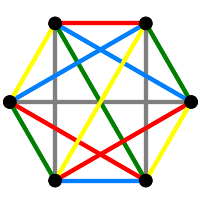Section4.3The McLaughlin Graph
A partition \((S,\comp{S})\) of \(V(G)\) determines a bipartite subgraph of \(G\); if we replace this subgraph by its bipartite complement, we say that the resulting graph is obtained by switching on \(S\) (or on \(\comp{S}\)). If \(S\) is the neighborhood of a vertex \(u\) in \(G\), then after switching on \(S\) the vertex \(u\) is isolated.
We construct a graph on the blocks of the \(4\)-\((23,7,1)\) design formed by the words of weight seven in the binary Golay code of length 23. (This graph is strongly regular.) We then add 23 vertices \(\{0,\ldots,23\}\) corresponding to the 23 coordinate positions of a code word, and join the \(i\)-th new vertex to the blocks that do not contain it. The resulting graph is not regular but if we switch on one of the new vertices and then delete it we get the McLaughlin graph on 275 vertices, which is strongly regular.
It's strongly regular, with a big automorphism group:
The McLaughlin graph gives rise to a regular two-graph. For details on regular two-graphs, see any recent book on algebraic graph theory.
The graph constructed here is distance-regular with diameter three on 552 vertices. (You can check these claims.) The vertices are partitioned into 276 pairs of vertices distance three, and the map that swaps the vertices in each pair is a central element of order two in the automorphism group of SMcL. The quotient over this element is McLaughlin's simple group.
